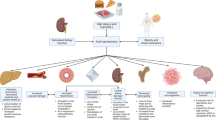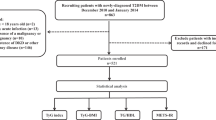Abstract
Altered plasma levels of branched-chain amino acids (BCAAs) and aromatic amino acids (AAAs) may predict the development of insulin resistance and other type 2 diabetes mellitus (T2DM) associated comorbidities. To elucidate the role of plasma free amino acids (PFAAs) profile as a biomarker for early detection of diabetic kidney disease, quantitative measurement of PFAAs profile was determined for 90 T2DM subjects, 30 were free of nephropathy, 30 with microalbuminuria, 30 with macroalbuminuria, and in addition to 30 healthy controls. The plasma levels of valine, leucine, isoleucine, phenylalanine, citrulline, and total BCAAs were significantly increased in diabetic normoalbuminuria group when compared to controls. However, the total BCAAs level was significantly decreased in diabetic patients with micro and macroalbuminuria. Other amino acid plasma levels as tyrosine, arginine, ornithine, glycine, and the total AAAs level were significantly decreased in all diabetic subgroups compared to controls. Significant positive correlations between total BCAAs, valine, leucine, isoleucine, serum insulin, glucose, and HOMA-IR values in the diabetic normoalbuminuria group were found. The use of altered PFAAs profile as a prognostic factor in T2DM patients at risk for microalbuminuria or macroalbuminuria might reduce or prevent the incidence of end-stage diabetic renal disease.



Similar content being viewed by others
References
Leon, B. M., & Maddox, T. M. (2015). Diabetes and cardiovascular disease: Epidemiology, biological mechanisms, treatment recommendations and future research. World Journal of Diabetes, 6(13), 1246–1258.
Honardoost, M., Sarookhani, M. R., Arefian, E., & Soleimani, M. (2014). Insulin resistance associated genes and miRNAs. Applied Biochemistry and Biotechnology, 174(1), 63–80.
de Zeeuw, D., Remuzzi, G., Parving, H. H., Keane, W. F., Zhang, Z., Shahinfar, S., Snapinn, S., Cooper, M. E., Mitch, W. E., & Brenner, B. M. (2004). Proteinuria, a target for renoprotection in patients with type 2 diabetic nephropathy: lessons from RENAAL. Kidney International, 65(6), 2309–2320.
Chen, X., & Yang, W. (2015). Branched-chain amino acids and the association with type 2 diabetes. Journal of Diabetes Investigation, 6(4), 369–370.
Pena, M. J., Lambers Heerspink, H. J., Hellemons, M. E., Friedrich, T., Dallmann, G., Lajer, M., Bakker, S. J., Gansevoort, R. T., Rossing, P., de Zeeuw, D., & Roscioni, S. S. (2014). Urine and plasma metabolites predict the development of diabetic nephropathy in individuals with type 2 diabetes mellitus. Diabetic Medicine, 31(9), 1138–1147.
Kolanu, B. R., Boddula, V., Vadakedath, S., & Kandi, V. (2017). Amino acid (leucine) chromatography: a study of branched-chain aminoaciduria in type 2 diabetes. Cureus, 9, e1091.
Nishi, H., Yamanaka, D., Kamei, H., Goda, Y., Kumano, M., Toyoshima, Y., Takenaka, A., Masuda, M., Nakabayashi, Y., Shioya, R., Kataoka, N., Hakuno, F., & Takahashi, S. I. (2018). Importance of serum amino acid profile for induction of hepatic steatosis under protein malnutrition. Scientific Reports, 8(1), 5461.
Badoud, F., Lam, K. P., DiBattista, A., Perreault, M., Zulyniak, M. A., Cattrysse, B., Stephenson, S., Britz-McKibbin, P., & Mutch, D. M. (2014). Serum and adipose tissue amino acid homeostasis in the metabolically healthy obese. Journal of Proteome Research, 13(7), 3455–3466.
Kugimiya, A., & Fukada, R. (2015). Chemiluminescence detection of serine, proline, glycine, asparagine, leucine, and histidine by using corresponding aminoacyl-tRNA synthetases as recognition elements. Applied Biochemistry and Biotechnology, 176(4), 1195–1202.
Newgard, C. B., An, J., Bain, J. R., Muehlbauer, M. J., Stevens, R. D., Lien, L. F., Haqq, A. M., Shah, S. H., Arlotto, M., Slentz, C. A., Rochon, J., Gallup, D., Ilkayeva, O., Wenner, B. R., Yancy, W. S., Jr., Eisenson, H., Musante, G., Surwit, R. S., Millington, D. S., Butler, M. D., & Svetkey, L. P. (2009). A branched-chain amino acid-related metabolic signature that differentiates obese and lean humans and contributes to insulin resistance. Cell Metabolism, 9(4), 311–326.
Bi, X., & Henry, C. J. (2017). Plasma-free amino acid profiles are predictors of cancer and diabetes development. Nutrition and Diabetes, 7(3), e249.
Garibotto, G., Sofia, A., Saffioti, S., Bonanni, A., Mannucci, I., & Verzola, D. (2010). Amino acid and protein metabolism in the human kidney and in patients with chronic kidney disease. Clinical Nutrition, 29(4), 424–433.
Chuang, W.-H., Arundhathi, A., Lu, C., Chen, C.-C., Wu, W.-C., Susanto, H., Purnomo, J. D. T., & Wang, C.-H. (2016). Altered plasma acylcarnitine and amino acid profiles in type 2 diabetic kidney disease. Metabolomics, 12(6), 108.
Cano, N. J., Fouque, D., & Leverve, X. M. (2006). Application of branched-chain amino acids in human pathological states: renal failure. The Journal of Nutrition, 136(1), 299S–307S.
Adeva, M. M., Calvino, J., Souto, G., & Donapetry, C. (2012). Insulin resistance and the metabolism of branched-chain amino acids in humans. Amino Acids, 43(1), 171–181.
Kumar, M. A., Bitla, A. R., Raju, K. V., Manohar, S. M., Kumar, V. S., & Narasimha, S. R. (2012). Branched chain amino acid profile in early chronic kidney disease. Saudi Journal of Kidney Diseases and Transplantation, 23(6), 1202–1207.
Hirayama, A., Nakashima, E., Sugimoto, M., Akiyama, S., Sato, W., Maruyama, S., Matsuo, S., Tomita, M., Yuzawa, Y., & Soga, T. (2012). Metabolic profiling reveals new serum biomarkers for differentiating diabetic nephropathy. Analytical and Bioanalytical Chemistry, 404(10), 3101–3109.
Zhang, J., Yan, L., Chen, W., Lin, L., Song, X., Yan, X., Hang, W., & Huang, B. (2009). Metabonomics research of diabetic nephropathy and type 2 diabetes mellitus based on UPLC-oaTOF-MS system. Analytica Chimica Acta, 650(1), 16–22.
Chou, C. A., Lin, C. N., Chiu, D. T., Chen, I. W., & Chen, S. T. (2018). Tryptophan as a surrogate prognostic marker for diabetic nephropathy. Journal of Diabetes Investigation, 9(2), 366–374.
Puavilai, G., Chanprasertyotin, S., & Sriphrapradaeng, A. (1999). Diagnostic criteria for diabetes mellitus and other categories of glucose intolerance: 1997 criteria by the Expert Committee on the Diagnosis and Classification of Diabetes Mellitus (ADA), 1998 WHO consultation criteria, and 1985 WHO criteria. World Health Organization. Diabetes Research and Clinical Practice, 44(1), 21–26.
World Medical Association. (2013). World medical association declaration of Helsinki: ethical principles for medical research involving human subjects. JAMA, 310, 2191–2194.
Matthews, D. R., Hosker, J. P., Rudenski, A. S., Naylor, B. A., Treacher, D. F., & Turner, R. C. (1985). Homeostasis model assessment: insulin resistance and beta-cell function from fasting plasma glucose and insulin concentrations in man. Diabetologia, 28(7), 412–419.
Rahimi, N., Razi, F., Nasli-Esfahani, E., Qorbani, M., Shirzad, N., & Larijani, B. (2017). Amino acid profiling in the gestational diabetes mellitus. Journal of Diabetes and Metabolic Disorders, 16(1), 13.
Stancakova, A., Civelek, M., Saleem, N. K., Soininen, P., Kangas, A. J., Cederberg, H., Paananen, J., Pihlajamaki, J., Bonnycastle, L. L., Morken, M. A., Boehnke, M., Pajukanta, P., Lusis, A. J., Collins, F. S., Kuusisto, J., Ala-Korpela, M., & Laakso, M. (2012). Hyperglycemia and a common variant of GCKR are associated with the levels of eight amino acids in 9369 Finnish men. Diabetes, 61(7), 1895–1902.
Tanaka, T., Mochida, T., Maki, Y., Shiraki, Y., Mori, H., Matsumoto, S., Shimbo, K., Ando, T., Nakamura, K., Endo, F., & Okamoto, M. (2013). Interactive network analysis of the plasma amino acids profile in a mouse model of hyperglycemia. SpringerPlus, 2(1), 287.
Wild, S., Roglic, G., Green, A., Sicree, R., & King, H. (2004). Global prevalence of diabetes: estimates for the year 2000 and projections for 2030. Diabetes Care, 27(5), 1047–1053.
Lotta, L. A., Scott, R. A., Sharp, S. J., Burgess, S., Luan, J., Tillin, T., Schmidt, A. F., Imamura, F., Stewart, I. D., Perry, J. R., Marney, L., Koulman, A., Karoly, E. D., Forouhi, N. G., Sjogren, R. J., Naslund, E., Zierath, J. R., Krook, A., Savage, D. B., Griffin, J. L., Chaturvedi, N., Hingorani, A. D., Khaw, K. T., Barroso, I., McCarthy, M. I., O'Rahilly, S., Wareham, N. J., & Langenberg, C. (2016). Genetic predisposition to an impaired metabolism of the branched-chain amino acids and risk of type 2 diabetes: a Mendelian randomisation analysis. PLoS Medicine, 13(11), e1002179.
Xu, F., Tavintharan, S., Sum, C. F., Woon, K., Lim, S. C., & Ong, C. N. (2013). Metabolic signature shift in type 2 diabetes mellitus revealed by mass spectrometry-based metabolomics. The Journal of Clinical Endocrinology and Metabolism, 98(6), E1060–E1065.
Zhenyukh, O., Civantos, E., Ruiz-Ortega, M., Sanchez, M. S., Vazquez, C., Peiro, C., Egido, J., & Mas, S. (2017). High concentration of branched-chain amino acids promotes oxidative stress, inflammation and migration of human peripheral blood mononuclear cells via mTORC1 activation. Free Radical Biology & Medicine, 104, 165–177.
Yoon, M. S. (2016). The emerging role of branched-chain amino acids in insulin resistance and metabolism. Nutrients, 8(7), E405. https://doi.org/10.3390/nu8070405.
Torres-Leal, F. L., Fonseca-Alaniz, M. H., Teodoro, G. F., de Capitani, M. D., Vianna, D., Pantaleao, L. C., Matos-Neto, E. M., Rogero, M. M., Donato, J., Jr., & Tirapegui, J. (2011). Leucine supplementation improves adiponectin and total cholesterol concentrations despite the lack of changes in adiposity or glucose homeostasis in rats previously exposed to a high-fat diet. Nutrition & Metabolism (London), 8(1), 62.
Chen, X., Hermansen, K., & Jeppesen, P. B. (2012). Impact of glucagon-like peptide-1 (7–36) amide, isosteviol and 5-aminoimidazole-4-carboxamide 1-beta-d-ribofuranoside on leucine-mediated alpha-cell dysfunction. Diabetes, Obesity & Metabolism, 14(11), 1020–1031.
Chen, Q., & Reimer, R. A. (2009). Dairy protein and leucine alter GLP-1 release and mRNA of genes involved in intestinal lipid metabolism in vitro. Nutrition, 25(3), 340–349.
Welsh, P., Rankin, N., Li, Q., Mark, P. B., Wurtz, P., Ala-Korpela, M., Marre, M., Poulter, N., Hamet, P., Chalmers, J., Woodward, M., & Sattar, N. (2018). Circulating amino acids and the risk of macrovascular, microvascular and mortality outcomes in individuals with type 2 diabetes: results from the ADVANCE trial. Diabetologia, 61(7), 1581–1591.
Cota, D., Proulx, K., Smith, K. A., Kozma, S. C., Thomas, G., Woods, S. C., & Seeley, R. J. (2006). Hypothalamic mTOR signaling regulates food intake. Science, 312(5775), 927–930.
Newgard, C. B. (2012). Interplay between lipids and branched-chain amino acids in development of insulin resistance. Cell Metabolism, 15(5), 606–614.
McCormack, S. E., Shaham, O., McCarthy, M. A., Deik, A. A., Wang, T. J., Gerszten, R. E., Clish, C. B., Mootha, V. K., Grinspoon, S. K., & Fleischman, A. (2013). Circulating branched-chain amino acid concentrations are associated with obesity and future insulin resistance in children and adolescents. Pediatric Obesity, 8(1), 52–61.
Kopple, J. D. (2007). Phenylalanine and tyrosine metabolism in chronic kidney failure. The Journal of Nutrition, 137, 1586S–1590S discussion 1597S–1598S.
Hellmuth, C., Kirchberg, F. F., Lass, N., Harder, U., Peissner, W., Koletzko, B., & Reinehr, T. (2016). Tyrosine is associated with insulin resistance in longitudinal metabolomic profiling of obese children. Journal Diabetes Research, 10. https://doi.org/10.1155/2016/2108909.
Lynch, C. J., & Adams, S. H. (2014). Branched-chain amino acids in metabolic signalling and insulin resistance. Nature Reviews. Endocrinology, 10(12), 723–736.
Sailer, M., Dahlhoff, C., Giesbertz, P., Eidens, M. K., de Wit, N., Rubio-Aliaga, I., Boekschoten, M. V., Muller, M., & Daniel, H. (2013). Increased plasma citrulline in mice marks diet-induced obesity and may predict the development of the metabolic syndrome. PLoS One, 8(5), e63950.
Viswanathan, V., Tilak, P., Meerza, R., & Kumpatla, S. (2010). Insulin resistance at different stages of diabetic kidney disease in India. Journal of the Association of Physicians of India, 58, 612–615.
Hsu, C. C., Chang, H. Y., Huang, M. C., Hwang, S. J., Yang, Y. C., Tai, T. Y., Yang, H. J., Chang, C. T., Chang, C. J., Li, Y. S., Shin, S. J., & Kuo, K. N. (2011). Association between insulin resistance and development of microalbuminuria in type 2 diabetes: a prospective cohort study. Diabetes Care, 34(4), 982–987.
Author information
Authors and Affiliations
Corresponding authors
Additional information
Publisher’s Note
Springer Nature remains neutral with regard to jurisdictional claims in published maps and institutional affiliations.
Rights and permissions
About this article
Cite this article
Saleem, T., Dahpy, M., Ezzat, G. et al. The Profile of Plasma Free Amino Acids in Type 2 Diabetes Mellitus with Insulin Resistance: Association with Microalbuminuria and Macroalbuminuria. Appl Biochem Biotechnol 188, 854–867 (2019). https://doi.org/10.1007/s12010-019-02956-9
Received:
Accepted:
Published:
Issue Date:
DOI: https://doi.org/10.1007/s12010-019-02956-9




